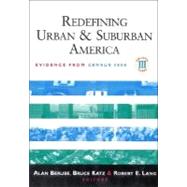Redefining Urban and Suburban America Evidence from Census 2000
, by Berube, Alan; Katz, Bruce; Lang, Robert E.- ISBN: 9780815708834 | 0815708831
- Cover: Paperback
- Copyright: 3/6/2006
Results from Census 2000 have confirmed that American cities and metropolitan areas lie at the heart of the nation's most pronounced demographic and economic changes. The third volume in the Redefining Urban and Suburban America series describes anew the changing shape of metropolitan American and the consequences for policies in areas such as employment, public services, and urban revitalization.The continued decentralization of population and economic activity in most metropolitan areas has transformed once-suburban places into new engines of metropolitan growth. At the same time, some traditional central cities have enjoyed a population renaissance, thanks to a recent book in "living" downtowns. The contributors to this book probe the rise of these new growth centers and their impacts on the metropolitan landscape, including how recent patterns have affected the government's own methods for reporting information on urban, suburban, and rural areas. Volume 3 also provides a closer look at the social and economic impacts of growth patterns in cities and suburbs. Contributors examine how suburbanization has affected access to employment for minorities and lower-income workers, how housing development trends have fueled population declines in some central cities, and how these patterns are shifting the economic balance between older and newer suburbs.Contributors include Thomas Bier (Cleveland State University), Peter Dreier (Occidental College), William Frey (Brookings), Robert Lang (Virginia Tech), Steven Raphael (University of California, Berkeley), Audrey Singer (Brookings), Michael Stoll (University of California, Los Angeles), Todd Swanstrom (St. Louis University), and Jill Wilson (Brookings).






